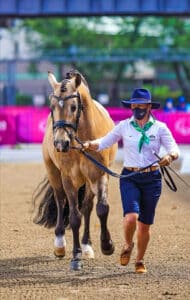If your horse becomes lame, investigation into the cause is vital. We spoke to Dr Doug English and asked for some advice.
While this might be stating the obvious, the most common causal factor producing lameness – defined as ‘an abnormal stance or gait caused by either a structural or a functional disorder of the locomotor system’ – is pain. However, the big question is what is it that’s causing the pain?
Generally speaking, most lameness originates in the forelegs, usually due to an issue below the knee, while a smaller percentage of cases affect the hind leg from the hock down. However, the limbs are by no means the only location that may need investigating; lameness can also be associated with the spine, neck, head, hip or shoulders.
If you can’t find an obvious cause for the lameness, diagnosis, followed by a course of treatment (which might involve a vet, farrier, or both) should be arranged promptly so that your horse’s pain can be relieved.

Most lameness originates in the forelegs, while a smaller percentage of cases affect the hind legs.
Investigating the cause
Depending on the cause of the problem, treatments for lameness vary greatly – and identifying the cause is often more difficult than it might sound. Some horses can be lame in multiple limbs, and the reasons why they might be lame vary considerably. Some of the usual suspects include:
Injury/Trauma: If this is the problem, there are normally visible signs. Look for any bleeding or swelling. If there’s bleeding, the injury should be appropriately treated. If you discover a swelling, gently probe by applying finger pressure, which will prompt a reaction from your horse if this is the site of their discomfort.
Infection: Other than occurring as a result of an injury, infections associated with lameness are frequently located in the hoof. This can be quite common in wet conditions when the hoof area softens, allowing sharp objects such as stones to breach the protective barrier and create conditions ripe for the growth of bacteria and potentially an abscess, which is an immensely painful condition. If a hoof infection is present, your horse will react to pressure from a hoof tester, or when the hoof is tapped with a small hammer
Arthritis: Associated with age, a previous injury, or an unbalanced diet (in particular a lack of calcium, which can occur with high grain diets or grazing on high oxalate tropical pasture), arthritis may be present in multiple joints, or even in the horse’s spine. Although it is often difficult to pinpoint its exact location, if in a joint there is likely to be swelling and asymmetry, and an accumulation of joint fluid which can cause pain and heat in the area.
Cancer: Osteosarcoma is a bone cancer occurring mostly in older horses. It begins insidiously and increases gradually, eventually producing obvious swelling in the affected bone. Diagnosis is by x-ray.
Genetic malfunction: This can include problems such as patella lock in the hind leg; cervical vertebral malformation (Wobbler syndrome) which constricts the spinal vertebrae; and malformations of the vertebrae. All of these conditions produce obvious gait abnormalities.
Identifying lameness
The trot is the ideal gait for identifying lameness, particularly if carried out on a hard surface. If possible, have someone lead the horse at trot, both away from you and back towards you. Also watch from the side as they are trotted past.
The most easily recognisable sign associated with forelimb lameness is the head bob. The horse’s head and neck lift when the lame leg strikes the ground and drop as the sound limb takes their weight.
In the case of hind leg lameness, the sacral rise – in which the pelvis on the affected side lifts as the lame leg strikes the ground and drops when the sound leg takes the horse’s weight – can indicate in which limb the horse is lame. A horse might also drag the toe of a lame hind leg. Have someone trot the horse directly away from you and watch to see whether the up and down movement of their hips is even or otherwise.
Both the head bob and the sacral rise help the horse to reduce stress on the lame limb and thus avoid additional pain. If you’re still unsure after the horse has been trotted up, lameness in both the fore and hind limbs is usually more noticeable when the horse is worked on a circle with the suspect limb to the inside. To locate the region accurately a veterinarian places local anaesthetic into nerves that supply specific anatomical areas, and a return to soundness will indicate the region.

A pre-event trot up – here at the Tokyo Olympics – ensures that horses are completely sound prior to competing (Image by Victoria Davies).
What’s next?
Other factors to consider in a diagnosis are whether the lameness is persistent (ongoing); intermittent (it comes and goes); static (the severity doesn’t change); progressive (becomes noticeably worse); and whether it improves with rest.
That’s quite a lot to consider, and even vets can at times have difficulties in identifying the cause of lameness. Fortunately, they are skilled in observing the horse in their entirety for further clues. They also have x-rays, scanning equipment and other diagnostic tools such as infrared photography (which pinpoints abnormal heat areas) at their disposal. So, while your horse’s lameness may simply have been caused by a stone bruise, if in doubt seek expert help – the earlier treatment begins, the better.
Feature Image: Vets are skilled at identifying causes of lameness and have a variety of diagnostic tools at their disposal.



